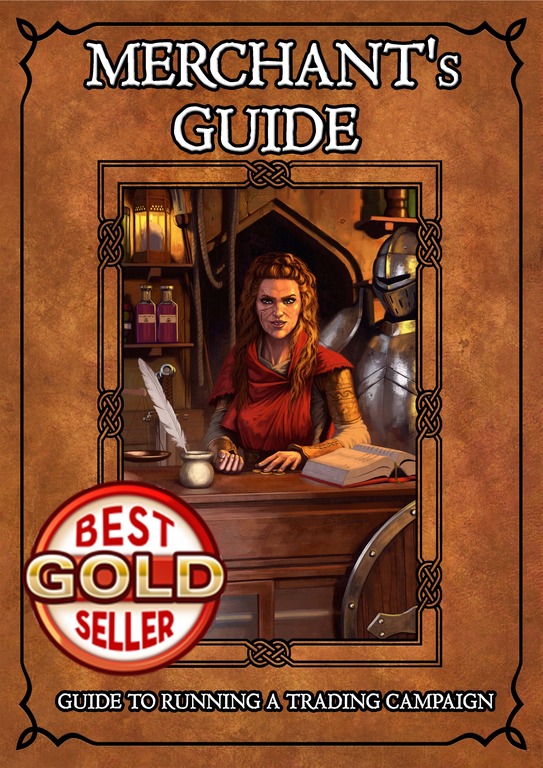TRADE GOODS – RAW MATERIALS
Previous article…D&D – Merchant #3 – Trade Goods – Finished Goods
Raw materials are the bricks of every solid Middle Age economy.
Kingdoms and Empires can’t exist without a constant, abundant and cheap supply of raw materials.
Expansionist wars are waged to gain access to strategic resources, so that new settlers may follow and, as usual, the merchants do the rest.
We have published the awesome Merchant Guide, a pdf available on DrivethruRpg. Just have a look at the preview to have an idea of the content.
Also, if you already have an idea on how to run your own trading campaign you may want to have a look at our Trade Goods Generator.
Small communities are usually the best provider of raw materials, may it be wood, crop, livestock, fish or whatever.
Once a small community grows and evolves, it learns to transform raw materials into finished goods.
This happens because a brave merchant take the risk to ship their stuff to far and more profitable markets.
So, let’s make a list of the most relevant raw materials…
Wood logs, stone slabs, sugar, coffee & tea, metal ingots, cotton & flax, wool, salt, pitch, grains, fruit, vegetables, hemp, slaves, hay, furs, livestock.
…and spend some words about each one.

COFFEE & TEA
Coffee, tea, or in general all those plants and seeds that react in boiled water may be included in this category.
COTTON & FLAX
This fibers all come from seasonal plants. It’s a cheap material and is employed in plenty of sectors. Maritime empires or mercantile city states can’t build a proper fleet that rule the sea, if they can’t control these raw materials.
FRUITS
Apples and berries, harvested from trees and bushes. Fruits are an essential food source. From time to time a merchant discover a new exotic fruit and build a fortune on it.
GRAIN
Wheat, rice, barley and corn. These are the bricks of any civilization. Capitals, cities and towns, all need grain and grain is never enough.
FURS
Hunters risk their lives to collect furs. Some animals are not offensive, but hard to catch, others are aggressive and dangerous like wolves and bears.
HAY
Hay is the main byproduct of grain. How many times have you seen a merchant shipping hay on his wagon, pulled by donkeys. Hay is the main food source for livestock. Where grain are farmed, hay is available, cheap and abundant. Where livestock is breed, hay is required.
HEMP
This strong and cheap fiber is considered an excellent substitute of cotton and linen.
LIVESTOCK
Pigs, cows, sheep, goats and horses are the most common livestock. However chickens, turkeys, camels and rabbits can be included as well as other more exotic species that yields milk, eggs, skin, furs and whatever. In a fantasy campaign setting some cultures employ reptiles as livestock, so everything is possible.
METAL INGOTS
Iron, copper, lead, tin or other common metals. These metals are smelted into ingots and then shipped. Mining communities have high strategic value and competition to ship these metals is very strong. Sometimes powerful merchant or merchant guilds patron these communities as a long term investment.
PITCH
Pitch is a key material employed in shipyards. Good as insulating and burning material. Pitch is obtained as byproduct from surface petroleum deposits.
SALT
Salt is vital. It is employed to conserve food. This raw material is harvested in coastal communities, but it’s not uncommon to find ancient salt deposits in dried lakes. Salt is probably the most expensive raw material, with its value comparable to silver.
SLAVES
Slavery is not always legal. Some countries forbid slavery, others thrive on them. Slaves can be of any race, but are usually intelligent or semi-intelligent humanoids. Merchant dealing with slaves can make great profits, provided they avoid certain countries.
STONE SLABS
Granite and basalt are the most common. Communities close to mountains may thrive on stone slabs commerce, especially if settled on a river so that this good can be easily shipped.
SUGAR
Farmed in tropical and subtropical environment, sugar is extracted from plants, with sugar and beetroot being the most common. Other exotic plants yielding sugar may exist.
VEGETABLES
Lettuce, tomatoes, potatoes and much more. Algae from the sea, or mushrooms from the depths,. Vegetables grow everywhere and are farmed everywhere.
WOOD LOGS
Forests and woods are everywhere. Hamlets are the main provider of wood logs, being wood a very common material to gather and stock.
CONCLUSIONS
So, this article completes the tour of the trade goods we consider relevant for a trading campaign.
The next step will be making a summary of all these goods, asking ourselves questions about the base value, price fluctuations and encumbrance.
At the same time we’ll have to spice up some of the entries described in the last three articles.
Trade goods may be available and ready to be shipped, however we may want to consider the possibility that a merchant stumble upon the chance of gathering some valuable trade goods.
Why not introducing an optional rule, for some of the trade goods, that can solve this issue?
What if a merchant and his hirelings encounter a creature that can provide a new, exotic and rare fur? Won’t they take the chance?
The next topics will be about base price, price fluctuations and encumbrance.
Encumbrance requires a simple solution. You know, when talking about encumbrance it’s always a struggle between weight and volume…you know what I am talking about.
Next Article…D&D – Merchant #5 – Trade Goods – Summary
